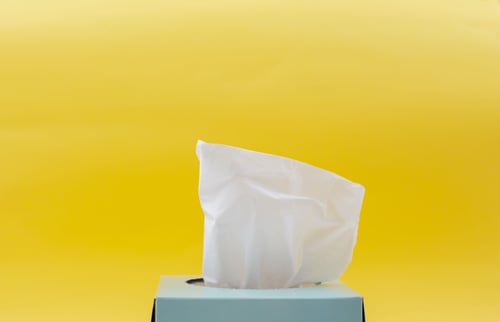
It’s likely happened to everyone at least once in their life: a warm gush of blood starts coming out of your nose, concerning you and everyone around you. While initially scary, nosebleeds are very common and typically not a sign of anything serious. Most nosebleeds are simply caused by dry or cold air, or local injury due to nose-picking! The nose has a lot of little, tiny blood vessels that are easily irritated so nosebleeds can also be caused by excessively forceful nose blowing when you’re sick or your allergies are flaring up. To prevent nosebleeds, use a humidifier in the bedroom while you sleep to make the air less dry, especially in the winter months when the air is naturally colder and drier. If you are particularly prone to nosebleeds, you can keep the inside of your nose moist with a nasal saline spray or even a thin layer of petroleum jelly (Vaseline). If your child is prone to nose-picking, keep their nails cut short to prevent any local trauma to the nostrils that may result in nosebleed. Nosebleeds can also be a result of excessive use of allergy/steroid nasal sprays. To help prevent this, spray away from the nasal septum (the middle part of the nose dividing the nostrils) by using the opposite hand to spray each nostril. For example, use your right hand to spray your left nostril and vice versa. This helps to direct the spray away from the area of blood vessels that are the most common sites of nosebleeds.
If you or your child develops a nosebleed, it’s important to remain upright and lean FORWARDS, not backwards. Leaning backwards for a nosebleed is a common misconception and can lead to aspiration or choking on blood. Firmly pinch the soft part of both nostrils, just below the nose bridge for at least 5-10 minutes (for children) and 10-15 minutes (for adults) to stop the source of the bleed. It’s crucial at this point to not release pressure early to check if the bleeding has stopped until the full recommended time has passed. Releasing pressure too early will make it harder for the bleeding to stop. If desired, you can also apply an ice pack or cold compress to the nose bridge to help constrict the blood vessels in the nose which will further aid in stopping the bleeding. If you happen to have it on hand, you can also try 2 sprays of Afrin or Mucinex nasal sprays in the bleeding nostril which will also cause the blood vessels to constrict to stop the bleed.
If you try all the above recommendations and the nosebleed still has not stopped after 30 minutes, go to the emergency department or an urgent care clinic. Other indications to seek emergent medical care after developing a nosebleed includes:
- Difficulty breathing
- Persistent nosebleed after facial trauma or injury
- Persistent nosebleed while on blood thinners or you have a clotting disorder
 Dr. Liu is a resident physician who sees patients of all ages and provides obstetrical services at Lone Star Family Health Center, a non-profit 501©3 Federally Qualified Health Center operating facilities in Conroe, Spring, Willis, Grangerland, and Huntsville, and serving as home to a fully integrated Family Medicine Residency Program to increase the number of Family Medicine physicians for Texas and our community.
Dr. Liu is a resident physician who sees patients of all ages and provides obstetrical services at Lone Star Family Health Center, a non-profit 501©3 Federally Qualified Health Center operating facilities in Conroe, Spring, Willis, Grangerland, and Huntsville, and serving as home to a fully integrated Family Medicine Residency Program to increase the number of Family Medicine physicians for Texas and our community.



